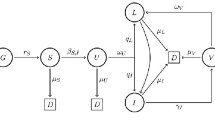Abstract
Nonlinear dynamical method of projecting the transmission of an epidemic is accurate if the input parameters and initial value variables are reliable. Here, such a model is proposed for predicting an epidemic. A method to supplement two variables and two parameters for this proposed model is demonstrated through a robust statistical approach. The method described here worked well in case of three continuous distributions. Model predictions could be lower estimates due to under-reporting of disease cases. Anad hoc procedure with a technical note is provided in the appendix
Similar content being viewed by others
References
Anderson R M 1988 The epidemiology of HIV infection: variable incubation plus infectious periods and heterogeneity in sexual activity.J. R. Stat. Soc. A151: 66–98
Anderson R M, May R M 1991Infectious diseases of humans: Dynamics and control (London: Oxford University Press)
Bain L J, Thoman D R 1968 Some tests of hypotheses concerning the three-parameter Weibull distribution.J. Am. Stat. Assoc. 63: 853–860
Bowman K O, Shenton L R 2001 Weibull distributions when the shape parameter is defined.Comput. Stat. Data Anal. 36: 299–310
Brookmeyer R, Gail M H 1988 A method for obtaining short-term projections and lower bounds on the size of the AIDS epidemic.J. Am. Stat. Assoc. 83: 301–308
Chen Z 1997 Statistical inference about the shape parameter of the Weibull distribution.Stat. Prob. Lett. 36: 85–90
Gray R Het al 2001 Probability of HIV-1 transmission per coital act in monogamous, heterosexual HIV-1-discordant couples in Rakai, Uganda.Lancet 357: 1149–1153.
Kakehashi M 1998 A mathematical analysis of the spread of HIV/AIDS in Japan IMA.J Math. Appl. Med. 15:299–311
Kakehashi M 1999 A mathematical analysis of the spread of HIV/AIDS in Japan IMA.J.Math. Appl. Med, 16: 111–112
Kakehashi M 2000 Validity of simple pair formation model for HIV spread with realistic parameter setting.Math. Pop. Stud, 8: 279–292
Kakehashi M, Rao A S R S 2004 Mathematical and statistical approaches to risk management for the prevention of HIV/AIDS and other infectious diseases.J. Med, Safety (in press)
Malik H J, Abraham B 1973 Multivariate logistic distributions.Ann. Stat. 1: 588–590
Murray J D 1989Mathematical biology (Berlin: Springer-Verlag)
Rao A S R S 2001 A methodology to estimate incubation distribution of AIDS in delayed surveillance and censored data.Int. Stat. Conf. on Environment and Pollution (Tokyo: The Biometric Society of Japan) pp 163–167
Rao A S R S 2003a Mathematical modelling of AIDS epidemic in India.Curr. Sci. 84: 1191–1197
Rao A S R S 2003b Can we obtain realistic HIV/AIDS estimates for Inida?J Biosci, 28, 4: 367–369
Rao A S R S 2004 Limiting theorems on ‘Case’ reporting.Appl. Math. Lett. (in press)
Rao A S R S and Kakehashi M 2002 Incubation time distribution in back-calculation applied to HIV/AIDS in India.Indian J. Pure Appl. Math, (submitted)
Rao C N and Srivenkataramana T 2001 Projection of HIV infections in India: An alternative to backcalculation.Curr. Sci. 81: 1302–1307
Rao A S R S, Basu S, Basu A, Ghosh J K 2002 Parametric models for incubation distribution in presence of left and right censoring.Indian J. Pure Appl. Math, (submitted)
Tarter M E 1966 Exact moments and product moments of the order statistics from the truncated logistic distribution.J. Am. Stat. Assoc. 61: 514–525
United Nations 2002 The UNAIDS Reference Group on Estimates, Modelling and Projections. Improved methods and assumptions for estimation of the HIV/AIDS epidemic and its impact: Recommendations of the UNAIDS Reference Group on Estimates, Modelling and Projections.AIDS 16(9):W1–14
Author information
Authors and Affiliations
Rights and permissions
About this article
Cite this article
Rao, A.S.R.S., Kakehashi, M. A combination of differential equations and convolution in understanding the spread of an epidemic. Sadhana 29, 305–313 (2004). https://doi.org/10.1007/BF02703780
Received:
Revised:
Issue Date:
DOI: https://doi.org/10.1007/BF02703780




